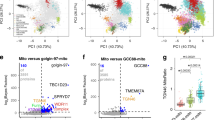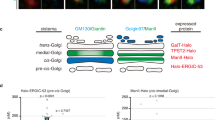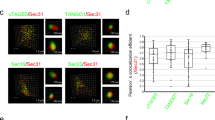Abstract
To dissect secretory traffic, we developed the retention using selective hooks (RUSH) system. RUSH is a two-state assay based on the reversible interaction of a hook protein fused to core streptavidin and stably anchored in the donor compartment with a reporter protein of interest fused to streptavidin-binding peptide (SBP). Biotin addition causes a synchronous release of the reporter from the hook. Using the RUSH system, we analyzed different transport characteristics of various Golgi and plasma membrane reporters at physiological temperature in living cells. Using dual-color simultaneous live-cell imaging of two cargos, we observed intra- and post-Golgi segregation of cargo traffic, consistent with observation in other systems. We show preliminarily that the RUSH system is usable for automated screening. The system should help increase the understanding of the mechanisms of trafficking and enable screens for molecules that perturb pathological protein transport.
This is a preview of subscription content, access via your institution
Access options
Subscribe to this journal
Receive 12 print issues and online access
$259.00 per year
only $21.58 per issue
Buy this article
- Purchase on Springer Link
- Instant access to full article PDF
Prices may be subject to local taxes which are calculated during checkout





Similar content being viewed by others
References
Mostov, K., Su, T. & ter Beest, M. Polarized epithelial membrane traffic: conservation and plasticity. Nat. Cell Biol. 5, 287–293 (2003).
Rodriguez-Boulan, E., Kreitzer, G. & Musch, A. Organization of vesicular trafficking in epithelia. Nat. Rev. Mol. Cell. Biol. 6, 233–247 (2005).
Hanus, C. & Ehlers, M.D. Secretory outposts for the local processing of membrane cargo in neuronal dendrites. Traffic 9, 1437–1445 (2008).
Lieu, Z.Z. et al. A trans-Golgi network golgin is required for the regulated secretion of TNF in activated macrophages in vivo. Proc. Natl. Acad. Sci. USA 105, 3351–3356 (2008).
Lock, J.G., Hammond, L.A., Houghton, F., Gleeson, P.A. & Stow, J.L. E-cadherin transport from the trans-Golgi network in tubulovesicular carriers is selectively regulated by golgin-97. Traffic 6, 1142–1156 (2005).
D′Angelo, G. et al. GRASP65 and GRASP55 sequentially promote the transport of C-terminal valine-bearing cargos to and through the Golgi complex. J. Biol. Chem. 284, 34849–34860 (2009).
Hicks, S.W., Horn, T.A., McCaffery, J.M., Zuckerman, D.M. & Machamer, C.E. Golgin-160 promotes cell surface expression of the beta-1 adrenergic receptor. Traffic 7, 1666–1677 (2006).
Matlin, K.S. & Simons, K. Reduced temperature prevents transfer of a membrane glycoprotein to the cell surface but does not prevent terminal glycosylation. Cell 34, 233–243 (1983).
Saraste, J. & Kuismanen, E. Pre- and post-Golgi vacuoles operate in the transport of Semliki Forest virus membrane glycoproteins to the cell surface. Cell 38, 535–549 (1984).
Kreis, T.E. & Lodish, H.F. Oligomerization is essential for transport of vesicular stomatitis viral glycoprotein to the cell surface. Cell 46, 929–937 (1986).
Lafay, F. Envelope proteins of vesicular stomatitis virus: effect of temperature-sensitive mutations in complementation groups III and V. J. Virol. 14, 1220–1228 (1974).
Arnheiter, H., Dubois-Dalcq, M. & Lazzarini, R.A. Direct visualization of protein transport and processing in the living cell by microinjection of specific antibodies. Cell 39, 99–109 (1984).
Presley, J.F. et al. ER-to-Golgi transport visualized in living cells. Nature 389, 81–85 (1997).
Scales, S.J., Pepperkok, R. & Kreis, T.E. Visualization of ER-to-Golgi transport in living cells reveals a sequential mode of action for COPII and COPI. Cell 90, 1137–1148 (1997).
Rivera, V.M. et al. Regulation of protein secretion through controlled aggregation in the endoplasmic reticulum. Science 287, 826–830 (2000).
Kuhn, Y. et al. Trafficking of the phosphoprotein PfCRT to the digestive vacuolar membrane in Plasmodium falciparum. Traffic 11, 236–249 (2010).
Saridaki, T., Sanchez, C.P., Pfahler, J. & Lanzer, M.A conditional export system provides new insights into protein export in Plasmodium falciparum-infected erythrocytes. Cell. Microbiol. 10, 2483–2495 (2008).
Sawyer, G.W., Ehlert, F.J. & Hart, J.P. Determination of the rate of muscarinic M1 receptor plasma membrane delivery using a regulated secretion/aggregation system. J. Pharmacol. Toxicol. Methods 53, 219–233 (2006).
Kondylis, V. & Rabouille, C. A novel role for dp115 in the organization of tER sites in Drosophila. J. Cell Biol. 162, 185–198 (2003).
Bard, F. et al. Functional genomics reveals genes involved in protein secretion and Golgi organization. Nature 439, 604–607 (2006).
Wendler, F. et al. A genome-wide RNA interference screen identifies two novel components of the metazoan secretory pathway. EMBO J. 29, 304–314 (2010).
Wilson, D.S., Keefe, A.D. & Szostak, J.W. The use of mRNA display to select high-affinity protein-binding peptides. Proc. Natl. Acad. Sci. USA 98, 3750–3755 (2001).
Keefe, A.D., Wilson, D.S., Seelig, B. & Szostak, J.W. One-step purification of recombinant proteins using a nanomolar-affinity streptavidin-binding peptide, the SBP-Tag. Protein Expr. Purif. 23, 440–446 (2001).
Honnappa, S. et al. An EB1-binding motif acts as a microtubule tip localization signal. Cell 138, 366–376 (2009).
Schutze, M.P., Peterson, P.A. & Jackson, M.R. An N-terminal double-arginine motif maintains type II membrane proteins in the endoplasmic reticulum. EMBO J. 13, 1696–1705 (1994).
Polishchuk, E.V., Di Pentima, A., Luini, A. & Polishchuk, R.S. Mechanism of constitutive export from the golgi: bulk flow via the formation, protrusion, and en bloc cleavage of large trans-golgi network tubular domains. Mol. Biol. Cell 14, 4470–4485 (2003).
Keller, P., Toomre, D., Diaz, E., White, J. & Simons, K. Multicolour imaging of post-Golgi sorting and trafficking in live cells. Nat. Cell Biol. 3, 140–149 (2001).
Emr, S. et al. Journeys through the Golgi—taking stock in a new era. J. Cell Biol. 187, 449–453 (2009).
Rothman, J.E. The future of Golgi research. Mol. Biol. Cell 21, 3776–3780 (2010).
Patterson, G.H. et al. Transport through the Golgi apparatus by rapid partitioning within a two-phase membrane system. Cell 133, 1055–1067 (2008).
Jordan, M., Schallhorn, A. & Wurm, F.M. Transfecting mammalian cells: optimization of critical parameters affecting calcium-phosphate precipitate formation. Nucleic Acids Res. 24, 596–601 (1996).
Moutel, S. et al. A multi-Fc-species system for recombinant antibody production. BMC Biotechnol. 9, 14 (2009).
Moutel, S. et al. Fully in vitro selection of recombinant antibodies. Biotechnol. J. 4, 38–43 (2009).
Slot, J.W. & Geuze, H.J. Cryosectioning and immunolabeling. Nat. Protoc. 2, 2480–2491 (2007).
Acknowledgements
We acknowledge members of the cell imaging platform of the Institut Curie (PICT-IBISA platform), especially V. Fraisier and P. Paul-Gilloteaux, and members of the Recombinant Antibodies and Proteins Platform, Curie Institute, for their support; M. Romao for technical help with electron microscopy; and E. del Nery for help with development of automated screening. We thank A. Akhmanova (Erasmus Medical Center, Rotterdam), V. Malhotra (Center for Genomic Regulation, Barcelona), A. El Marjou, P. Benaroch, S. Dufour (Institut Curie) for providing us plasmids coding for STIM1-NN, Ii, SBP, VSVGwt and E-cadherin, respectively; and D. Stephens (University of Bristol) for antibody to Sec24; and B. Goud and T. Jones for critically reading the manuscript. This work was supported by the Centre National de la Recherche Scientifique, the Institut Curie, the Agence Nationale de la Recherche (ANR 09-BLAN-0290) and the Incentive and Cooperative Programs from the Institut Curie. V.M. was supported by the European Molecular Biology Organization.
Author information
Authors and Affiliations
Contributions
G.B. carried out most of the experiments, designed and set up some of the approaches, analyzed the data, prepared the figures and wrote the manuscript. S.D. was involved in most of the molecular biology experiments and carried out the biochemical experiments. N.G. was involved in the molecular biology experiments and in selection of the stable cell lines. H.d.F. carried out the total internal reflection fluorescence experiment. A.L. contributed to automated screening. L.L. established the stable cell lines. V.M. was involved at the very beginning of the project. F.J. was involved at the very beginning of the project. G.R. did the electron microscopy experiments, prepared the corresponding figure and corrected the manuscript. F.P. designed and supported the study, directed the work, analyzed the data and wrote the manuscript.
Corresponding author
Ethics declarations
Competing interests
F.P. is the author of a patent application that covers the commercial use of the RUSH system (EP2010/058229 and WO/2010/142785).
Supplementary information
Supplementary Text and Figures
Supplementary Figures 1–8 (PDF 13060 kb)
Supplementary Video 1
Real-time imaging of the synchronized trafficking of ManII-SBP-EGFP (corresponds to Fig. 3a). HeLa cells were transfected to express Ii-streptavidin as a hook and ManII-SBP-EGFP as a reporter. After 20 h of expression, at time 00:00, release of the reporter was induced by addition of biotin and monitored using a spinning disk confocal microscope. (MOV 5962 kb)
Supplementary Video 2
Real-time imaging of the synchronized trafficking of TNFα-SBP-EGFP (corresponds to Fig. 3b). HeLa cells were transfected to express Ii-streptavidin as a hook and TNFα-SBP-EGFP as a reporter. After 20 h of expression, at time 00:00, release of the reporter was induced by addition of biotin and monitored using a spinning disk confocal microscope. (MOV 3462 kb)
Supplementary Video 3
Real-time imaging of the synchronized trafficking of SBP-EGFP-E-cadherin (corresponds to Fig. 3c). HeLa cells were transfected to express Ii-streptavidin as a hook and SBP-EGFP–E-cadherin as a reporter. After 20 h of expression, at time 00:00, release of the reporter was induced by addition of biotin and monitored using a spinning disk confocal microscope. (MOV 6718 kb)
Supplementary Video 4
Real-time imaging of the synchronized trafficking of VSVGwt-SBP-EGFP. HeLa cells were transfected to express Ii-streptavidin as a cytoplasmic hook and VSVGwt-SBP-EGFP as a reporter. After 20 h of expression, at time 00:00, release of the reporter was induced by addition of biotin and monitored using a spinning disk confocal microscope. (MOV 901 kb)
Supplementary Video 5
Real-time TIRF microscopy of TNFα-SBP-EGFP exocytosis (corresponds to Supplementary Fig. 7). HeLa cells were transfected to express Ii-streptavidin as a hook and TNFα-SBP-EGFP as a reporter. Twenty-eight minutes after the addition of biotin, exocytosis at the plasma membrane was observed using TIRF microscopy. Many bursts of exocytosis can be observed in the two cells present in the field. Duration of the acquisition is indicated in min:s.ms. (MOV 1220 kb)
Supplementary Video 6
Dual-color, real-time imaging of the synchronized trafficking of TNFα-SBP-EGFP and ManII-SBP-mCherry (corresponds to Fig. 4a–g). HeLa cells were transfected to express Ii-streptavidin as a hook and TNFα-SBP-EGFP (green) and ManII-SBP-mCherry (red) as reporters. Twenty hours after transfection, at time 00:00, the release was induced by addition of biotin. Images were acquired using a confocal spinning disk microscope. (MOV 4468 kb)
Supplementary Video 7
Dual-color imaging of the synchronized trafficking of TNFα-SBP-EGFP and SBP-mCherry–E-cadherin (corresponds to Fig. 4h–j). HeLa cells were transfected to express Ii-streptavidin as a hook, TNFα-SBP-EGFP (green) and SBP-mCherry–E-cadherin (red). After 20 h of expression, at time 00:00, release of the fluorescent reporters was induced by addition of biotin and monitored using a spinning disk confocal microscope. Time is indicated in min:s. (MOV 5433 kb)
Rights and permissions
About this article
Cite this article
Boncompain, G., Divoux, S., Gareil, N. et al. Synchronization of secretory protein traffic in populations of cells. Nat Methods 9, 493–498 (2012). https://doi.org/10.1038/nmeth.1928
Received:
Accepted:
Published:
Issue Date:
DOI: https://doi.org/10.1038/nmeth.1928
This article is cited by
-
A defined clathrin-mediated trafficking pathway regulates sFLT1/VEGFR1 secretion from endothelial cells
Angiogenesis (2024)
-
Spatial proteomics reveals secretory pathway disturbances caused by neuropathy-associated TECPR2
Nature Communications (2023)
-
Transfer learning for versatile and training free high content screening analyses
Scientific Reports (2023)
-
Single-frame deep-learning super-resolution microscopy for intracellular dynamics imaging
Nature Communications (2023)
-
Nutrient deprivation alters the rate of COPII subunit recruitment at ER subdomains to tune secretory protein transport
Nature Communications (2023)



